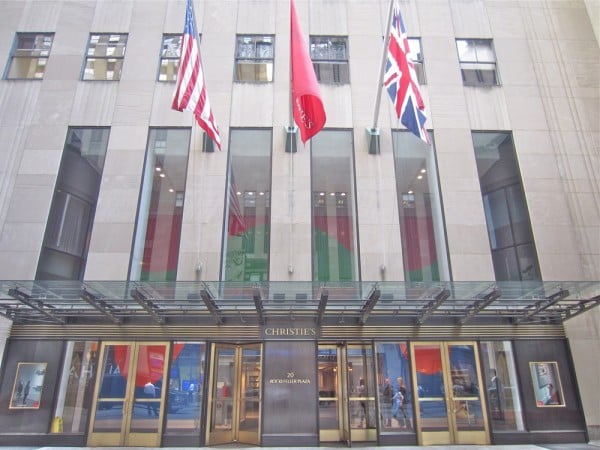Art Guides
Why Is Christie’s Shaking Up Its Spring Auction Schedule?
The move allows the house to play up its stronger sale.

The move allows the house to play up its stronger sale.

Brian Boucher &
Eileen Kinsella

Christie’s has quietly altered its New York spring auction schedule.
Could it be a bid to play up its dominance in the postwar and contemporary market while downplaying its less-inspiring Impressionist offerings?
Some observers have suggested to artnet News that the move may also free up staff resources at Christie’s, which is owned by megacollector François Pinault, for events he may be organizing in Venice at that time, during the opening festivities for the Venice Biennale.
Typically Christie’s and Sotheby’s hold their evening sales of Impressionist and modern art on the first Tuesday and Wednesday of May, followed by the larger postwar and contemporary art sales the same days the following week.
Next month, however, the only sale during the first week will be Sotheby’s Impressionist/modern sale.

Christie’s New York, at Rockefeller Center.
As a result, the second week will see five evening sales across three auction houses. We’ll see a postwar and contemporary art sale at Sotheby’s on Tuesday, and then Christie’s postwar and contemporary sale on Wednesday.
The following night, to finish off the season, comes Christie’s Impressionist and modern sale, on Thursday, May 14. The two houses’ much smaller competitor, Phillips, also holds its contemporary art sale the same night.
Christie’s move may spare the house from appearing in dispiriting headlines like “Christie’s Starts Auction Season with Lackluster Impressionist Sale.” All the same, it may expose the auctioneer to buyer fatigue, coming at the end of such a busy week.
Shifting sales from one night to another is not unheard of. Phillips, in November of 2013, moved its contemporary art sale from Thursday to Monday, hoping to lure collectors before they were tapped out.
The first calendar change at Christie’s was the addition of a May 11 sale organized by contemporary art specialist Loïc Gouzer, titled “Looking Forward to the Past.” The house announced it in late March. It features both modern and contemporary art, including a Picasso estimated at an eye-popping $140 million (see $140 Million Picasso is World’s Most Expensive Painting at Auction).
Gouzer organized a successful contemporary art sale for the house in May 2014, promoted as focusing on the “gritty underbelly” of contemporary art. It preceded the larger modern and contemporary art sales, taking place on Monday. It squeaked by its high estimate to total $135 million and set records for a dozen artists, including Dan Colen, Wade Guyton, On Kawara, Martin Kippenberger, Richard Prince, and R.H. Quaytman.
While much attention is devoted to Christie’s consistently record-setting contemporary art sales in recent years (see Epic Christie’s $852.9 Million Blockbuster Contemporary Sale Is Highest Ever), Sotheby’s has been making strides in the Impressionist and modern art market.
At the November 2014 Impressionist evening sales, Sotheby’s took in $422 million, its highest-ever auction, while Christie’s evening sale realized just $165 million (see $101 Million Giacometti Leads Sotheby’s $422 Million Impressionist Sale and $65 Million Manet Leads at Christie’s $165 Million Impressionist Sale).
This time around, the May 5 evening sale at Sotheby’s features 69 lots with a presale estimate of up to $366.7 million. Christie’s has not yet supplied a presale estimate for all of its Impressionist and modern art offerings but the total will presumably be bolstered by both a Picasso and a Monet at the Monday “Looking Forward to the Past” sale. The combined high estimate of the Picasso and the Monet comes to $185 million.
The Thursday night sale is expected to exceed $100 million (see Goldman Sachs Chair John C. Whitehead’s $40-Million Impressionist Collection Goes to Christie’s).
Christie’s has made no formal announcement of the change. In answer to an email from artnet News, a Christie’s representative said: “After adding Looking Forward to the Past, with its blend of Impressionist, modern, post-war, and contemporary objects, we realized we had an opportunity to re-invent the sale calendar for this season and fully embrace the cross-category collecting approach to the benefit of our clients. More and more we are seeing clients approach their collecting in increasingly boundary-less ways, and our sales this season have been curated and scheduled with this evolving trend in mind.”
Interestingly, Christie’s has tried to shift the paradigm before, in the late ’90s, and it didn’t work.
“Christie’s aimed to alter the categories by which art was auctioned, when they noted that some of the same people who were buying Picasso were also buying Eva Hesse,” New York dealer Cristin Tierney told artnet News (see Dealer Spotlight: Cristin Tierney).
“They put the Impressionists together with Corot in a 19th-century sale, and Picasso and Rauschenberg were lumped together in a 20th-century sale, and contemporary was defined as post-1968.” It lasted a year or two but then the house reverted to its previous formats, she said.
“The shift makes more sense now,” Tierney observed, “when lots of the same people who are buying late Picassos also want Jean-Michel Basquiat. And those things make sense on a wall together.”